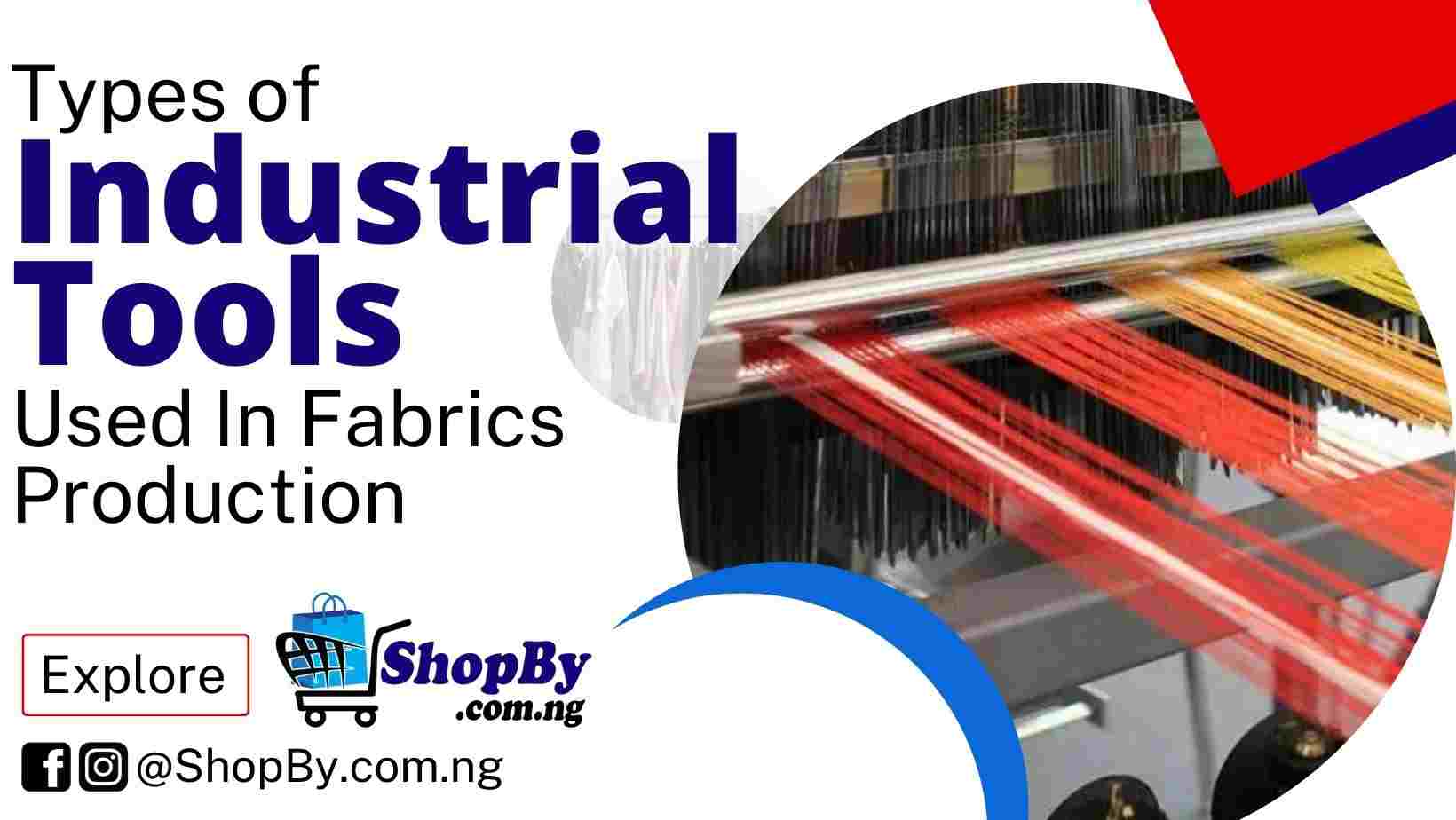- Your cart is empty
- Continue Shopping
TYPES OF INDUSTRIAL TOOLS USED IN FABRICS PRODUCTION

Types of Industrial Machine Used In Fabrics Production
INTRODUCTION
Fabrics is cloth or other material produced by weaving together cotton, nylon, wool, silk, or other threads. Fabrics are used for making things such as clothes, curtains, and sheets. Fabrics production is no simple task.
The industry makes our clothes, curtains, types of flooring, and even furniture. Because it has such an impact on our lives, the textile industry is large and has a high demand. But how does an industry produce all of the products we want and need? Well, there are specialized machines that make the items quickly and efficiently.
TYPES OF INDUSTRIAL MACHINE USED IN FABRICS PRODUCTION
Every industry has machines separately involving fiber/fabrics production and few for textile production.
A wide variety of machines are used by the textile industry to sew fabrics and make clothes, carpets and other textile goods. Ranging from massive heavy-duty industrial machines to small consumer-sized.
COTTON GIN
Cotton is one of the primary fabrics utilized in the textile industry. This means there needs to be an efficient machine that can separate the cotton fibers from the cotton seed. The cotton gin is responsible for not only completing the separation process, but also removes stems, leaves, and other dirty matter from the cotton.
SPINNING MACHINES
Before a thread can be woven together, you have to create the thread through spinning. Spinning machines spin substances like cotton into a piece of yarn or thread. The yarn or thread can then be weaved or knitted together to create a piece of fabric.
LOOMS
Looms are used to weave pieces of thread together. The loom can weave threads that are one color or can weave multiple colors to create a pattern or design. There are three common weaves a loom performs, and they include the plain weave, satin weave, and twill.
KNITTING MACHINES
Thread or yarn that is not weaved together, is often knitted together. Much like the hand process of knitting, knitting machines use needles to pull yarn through hoops to create stitches that hold it together.
BLEACHING/DYEING MACHINES
Many pieces of fabric are colorful. While some may have started that color, most are probably dyed. Dyeing machines are responsible for adding color to the yarn or fabric. In contrast to dyeing, bleaching is applied to remove pigments and natural dyes that are in the fibers. It’s nothing but a chemical treatment employed for natural coloring matter from the substrate. Bleaching can be performed on yarn, knitted fabric and woven ones. A method for coloring a textile material, in which a dye is applied to the substrate in a uniform manner. When colors of different shades are applied to fabric, the principle of dyeing actually works.
CARDING MACHINES
The word is derived from the Latin Carduus meaning thistle or teasel as dried vegetable teasels were first used to comb the raw wool before technological advances led to the use of machines
.Carding is a mechanical process that disentangles, cleans and intermixes fibers to produce a continuous web or sliver suitable for subsequent processing. This is achieved by passing the fibers between differentially moving surfaces covered with “card clothing”, a firm flexible material embedded with metal pins.In preparing wool fiber for spinning, carding is the step that comes after teasing.
SCUTCHING MACHINES
Scutching is a step in the processing of cotton or the dressing of flax or hemp in preparation for spinning. The scutching process separates the impurities from the raw material, such as the seeds from raw cotton or the straw and woody stem from flax fibers. Scutching can be done by hand or by a machine known as a scutcher. Hand scutching of flax is done with a wooden scutching knife and a small iron scraper. The end products of scutching flax are the long finer flax fibers called line, short coarse fibers called tow, and waste woody matter called shives Cotton seeds from the cotton are separated with the help of these scutching machines. Scutching is a step in the processing of cotton in preparation for spinning. The process is usually done by hand or by a machine known as a scutcher.
WINDING MACHINES
A Winding Machine is a machine for wrapping string, twine, cord, thread, yarn, rope, wire, ribbon, tape, etc. onto a spool, bobbin, reel, etc. Winders are used heavily in textile manufacturing, especially in preparation for weaving where the yarn is wound onto a bobbin and then used in a shuttle.
Winding machines are classified based on the materials they are winding, some major types are
- Coil winding machine
- Film winding machine
- Rope winding machine
- Paper winding machine
- Foil winding machine
- Roll slitting machines
- spool winding machine
- cop winding machine
FINISHING MACHINES
When the yarn has been knitted together, the finishing machine is used to make sure the fabric won’t come apart and to strengthen it. Some finishing machines compact the fabric together so that it can be sewn into different pieces like ropes. Some finishing machines remove water from the materials so that colors don’t bleed, or the fabric does not shrink. Additionally, some finishing machines remove wrinkles from the fabric.
CONCLUSION
The textile industry plays a significant role in the Nigerian economy by providing direct employment for citizens in the country and at large. That is why it is very necessary to know the Types of Industrial Machine Used In Fabrics Production.
Hope this content “Types of Industrial Machine Used In Fabrics Production” was helpful, for more info Contact Us
Might Be of Interest to you “How Culture is Reflected in Fashion“




